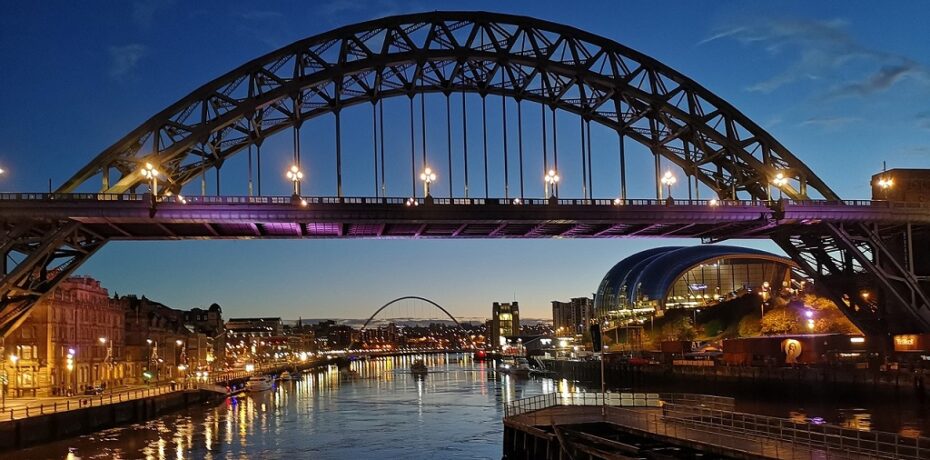The Subplot
The Subplot | What the Tyne Bridge tell us about Northern infrastructure
Welcome to The Subplot, your regular slice of commentary on the business and property market from across the North of England and North Wales.
THIS WEEK
- A long, hard road: delivering even much-wanted infrastructure projects is getting harder
- Elevator pitch: your weekly rundown of what is going up, and what is heading the other way
INFRASTRUCTURE INERTIA
Don’t startle the fish: what the Tyne Bridge tells us about Northern infrastructure
Why is it so difficult getting the North of England’s infrastructure built?
It’s been a long time coming, and will take four years to complete, but the Tyne Bridge will at last be refurbished following confirmation of £35.2m government funding for the £41.4m job. But the project gets underway as the UK’s capacity to build and manage major infrastructure comes under pressure. The complaint is that everything takes forever, and costs far more than it does elsewhere in Europe. The iconic Tyne Bridge make a great place to stand and ask, why?
Treasury brain
First, let’s tell the story of the Tyne Bridge, a project everyone agrees is worthwhile and important. Local councils began to lobby the government to help fund the vital project in 2016. Six years later in October 2022 ministers agreed, then there was silence while local councils completed the business case, a silence broken this month, when ministers said they would indeed come up with the money. A government announcement said it was part of the dividend of cancelling HS2 north of Birmingham. So that’s seven, nearly eight years.
Valuations
But you can’t just blame a slow-moving Treasury. Maybe the design of some projects is part of the problem, as a just-published Centre for Growth report suggests. The report says: “A common theme across UK infrastructure is that specifications and standards go beyond what is necessary. This… largely comes back to risk aversion.” They say HS2 fell into this trap.
But there’s a second problem, which the authors call “incorrect valuation.” They explain: “Too often the valuation approach taken focuses on the benefits which are easiest to estimate, even when they may not actually be the primary objectives.” The report confesses that yes, gold-plating environmental standards “does incur very real costs” but goes on to add that isn’t the whole story.
A long road ahead
The Tyne Bridge refurb was certainly never going to be quick. Repainting it, installing new drains, plus repairs to steelwork, masonry, and joints of the 530 ft bridge will take four years, a year longer than it took to build it in the first place (1925-1928). Preliminary work has been done but Esh Construction has yet to come up with a timetable, so the clock isn’t properly ticking. Also, note the Centre for Growth calculates that 69% of UK road projects overrun their timetable. The aim is to complete the Tyne Bridge refurbishment by its centenary in 2028.
Birds and fish
There are also environmental issues to complicate matters. There’s the nesting kittiwakes, of course, and special ‘hotels’ for them will be built into the scaffolding, but on top of this is the UK’s Marine Management Organisation, which has agreed to allow the refurb but only on the condition that no direct lights will shine on the water. This is in case it affects fish behaviour. Subplot asked the MMO if that meant limited night-work (night-work might have reduced congestion issues, and sped things up), and were told there were no conditions on start and finish times. Newcastle City Council added that congestion-causing lane closures would operate 24 hours a day (and last for much of the four years) so night-working wouldn’t make much difference to the speed of the project. So, there we are – we can’t blame salmon for years of traffic jams.
Delays and congestion
The longer the job, the more it becomes a nuisance and cost to the local economy. During bridge works capacity on the bridge will halve from the current figure of 70,000 vehicles daily. Newcastle City Council confesses “heavy congestion is expected on all approaches to the Tyne Bridge on both Newcastle and Gateshead sides,” particularly the Quayside route, Swing Bridge, and routes to and from Redheugh Bridge. This is sure to come at a significant economic cost of adding 30-40 minutes to journeys, and messing up bus services, although Subplot’s efforts to find an assessment of how much have so far come to nothing. If you’ve seen one, please shout. There presumably must be such a thing because a committee of what will soon be the North East Combined Authority agreed to spend £3.4m to ease some of the pain.
Everyone loves it
However, we have estimates of some of the upsides, although as Subplot went to pixel it wasn’t clear whose estimates those were, or when they did the estimating. These include a £90m boost to tourism (it’s unclear over what period) and air quality improvement as lorries are re-routed from residential areas (although presumably with a downside for the city centre?). Both Newcastle and Gateshead councils thought the £90m figure was from government, not them. A value-for-money case has been made, which isn’t quite the same thing.
Subplot asked Newcastle City Council if they could share the economic impact paperwork, but hasn’t yet heard back. Another reminder: this is a project everyone already agrees is a good idea, so imagine how much harder it would be if that were hotly disputed, and protesters were chasing figures and fighting every inch.
Before that, this
All of this matters because without well thought-out, timely, and value-for-money infrastructure you can’t build, and ultimately your economy is screwed. It’s now four years since the government declared it would adopt an “infrastructure first” approach to development. The National Infrastructure Commission has estimated that both public and private sector infrastructure investment will need to increase by 30% to 50% over the next decade. There’s a crisis coming: somebody needs to get a grip. Fingers crossed that by the time the Tyne Bridge refurb is completed it will have been sorted out.
 ELEVATOR PITCH
ELEVATOR PITCH
Going up, going down. This week’s movers
Adding extra floors to existing buildings gets just a tiny bit easier, as the risk that city living poses to nightlife venues gets just a little bit more pressing. Doors closing.
 Noisy neighbours
Noisy neighbours
Nobody likes disturbed sleep but the property industry has more reason to fear it than most. Night & Day Cafe, a Manchester nightlife institution, was served a noise abatement notice in 2021 after a complaint by the resident of a new city centre apartment. It caused a sensation and led to a 94,000-signature petition to have it revoked. Supporters included Manc pop luminary Johnny Marr.
With the resident now moved out, and no further complaints it was hoped the matter was over. But Manchester City Council decided to fight on, insisting a residents’ right to enjoy their home was worth fighting for. A decision is due any day. Night & Day survived a similar crisis in 2014.
This kind of case shouldn’t be happening because in 2018 the rules were changed to prevent the rise in city living from squeezing out noisy fun. An “agent of change” principle was introduced into the National Planning Policy Framework which meant it was the developer of the apartments who had to do the work, not the existing music venue that had to surrender. There are understood to be planning conditions in place in this case.
Specialists have been saying for a while that in practice the 2018 change isn’t very helpful because the planning conditions to require acoustic insulation aren’t enforced. Consultant Bidwells said the rule has no “meaningful effect.” The government recently tried to close the gap between planning law and licensing law by making the “agent of change” principle a factor to be taken into account under the Licensing Act, but the Night & Day case makes that look shaky.
The city living noise controversy is proving hard to quieten. Residential developers – and music venues – will both have sleepless nights as a result.
 Extra floors
Extra floors
Thinking of converting an office block into apartments? Hoping to stick a few more floors on top? The government has your back. Consultation began yesterday on plans to (very slightly) ease the permitted development rights to allow buildings to go up with even less planning fuss.
Since 2020, owners have had permitted development rights but with a few limitations. The building must be post-war and it must look okay, meaning match the local design code. The government is thinking of relaxing both those constraints, to allow buildings after 1930 (maybe) and to simplify approval on design (maybe). It’s hard to see these changes making much difference – if the maths work, developers will go ahead and if it doesn’t, they won’t. The real viability constraints here are on safety, especially post-Grenfell fire safety rules for buildings over 18 metres tall, which would be untouched by the latest proposed changes.
You can have your say by responding to the consultation.
Get in touch with David Thame: david.thame@placenorth.co.uk





Northern Infrastructure is a struggle because of the pathetic sums of money given to a region with 15 million people. These London politicians of both colours think the North is like the West Country, or East Anglia, where the biggest town is the size of Bolton.
By Elephant
Economic assessment of these type of projects should be pretty simple. Build a transport model, remove the bridge and the congestion will be significant. Value that benefits of relieving that congestion (i.e keeping the bridge) and bang you should have many £ms of benefits. Not maintaining the structure is effectively saying you eventually close it. We did this for many maintenance projects in the past to get funding from DfT.
By J